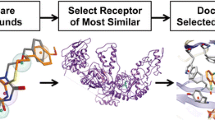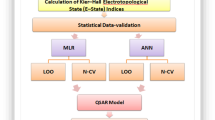Abstract
This article describes a molecular-field-based similarity method for aligning molecules by matching their steric and electrostatic fields and an application of the method to the alignment of three structurally diverse non-nucleoside HIV-1 reverse transcriptase inhibitors. A brief description of the method, as implemented in the program MIMIC, is presented, including a discussion of pairwise and multi-molecule similarity-based matching. The application provides an example that illustrates how relative binding orientations of molecules can be determined in the absence of detailed structural information on their target protein. In the particular system studied here, availability of the X-ray crystal structures of the respective ligand–protein complexes provides a means for constructing an 'experimental model' of the relative binding orientations of the three inhibitors. The experimental model is derived by using MIMIC to align the steric fields of the three protein P66 subunit main chains, producing an overlay with a 1.41 Å average rms distance between the corresponding Cα's in the three chains. The inter-chain residue similarities for the backbone structures show that the main-chain conformations are conserved in the region of the inhibitor-binding site, with the major deviations located primarily in the 'finger' and RNase H regions. The resulting inhibitor structure overlay provides an experimental-based model that can be used to evaluate the quality of the direct a priori inhibitor alignment obtained using MIMIC. It is found that the 'best' pairwise alignments do not always correspond to the experimental model alignments. Therefore, simply combining the best pairwise alignments will not necessarily produce the optimal multi-molecule alignment. However, the best simultaneous three-molecule alignment was found to reproduce the experimental inhibitor alignment model. A pairwise consistency index has been derived which gauges the quality of combining the pairwise alignments and aids in efficiently forming the optimal multi-molecule alignment analysis. Two post-alignment procedures are described that provide information on feature-based and field-based pharmacophoric patterns. The former corresponds to traditional pharmacophore models and is derived from the contribution of individual atoms to the total similarity. The latter is based on molecular regions rather than atoms and is constructed by computing the percent contribution to the similarity of individual points in a regular lattice surrounding the molecules, which when contoured and colored visually depict regions of highly conserved similarity. A discussion of how the information provided by each of the procedures is useful in drug design is also presented.
Similar content being viewed by others
References
Bugg, C.E., Carson, W.M. and Montgomery, J.A., Sci. Am., (1993) 92.
Gund, P., Prog. Mol. Subcell Biol., 5 (1977) 117.
Marshall, G.R., Barry, C.D., Bosshard, H.E., Dammkoehler, R.A. and Dunn, D.A., In Olson, E.C. and Christofferson, R.E. (Eds.) Computer-Assisted Drug Design, ACS Symposium Series, No. 112, American Chemical Society, Washington, DC, 1979, pp. 205–226.
Johnson, M.A. and Maggiora, G.M. (Eds.) Concepts and Applications of Molecular Similarity, Wiley, New York, NY, 1990.
Dean, P.M. (Ed.) Molecular Similarity in Drug Design, Blackie Academic, London, 1995.
Kearsley, S.K. and Smith, G.M., Tetrahedron Comput. Methodol., 3 (1990) 615.
Good, A.C., So, S.-S. and Richards, W.G., J. Med. Chem., 36 (1993) 433.
Perkins, T.D.J., Mills, J.E.J. and Dean, P.M., J. Comput.-Aided Mol. Design, 9 (1995) 479.
Grant, J.A., Gallardo, M.A. and Pickup, B.T., J. Comput. Chem., 17 (1996) 1653.
Klebe, G., Mietzner, T. and Weber, F., J. Comput.-Aided Mol. Design, 8 (1994) 751.
McMartin, C. and Bohacek, R.S., J. Comput.-Aided Mol. Design, 9 (1995) 237.
Lemmen, C. and Lengauer, T., J. Comput.-Aided Mol. Design, 11 (1997) 357.
Mestres, J., Rohrer, D.C. and Maggiora, G.M., J. Comput. Chem., 18 (1997) 934.
Mestres, J., Rohrer, D.C. and Maggiora, G.M., J. Mol. Graph. Modelling, 15 (1997) 114.
Klebe, G., In Kubinyi, H. (Ed.) 3D QSAR in Drug Design: Theory, Methods and Applications, ESCOM, Leiden, 1993, pp. 173–199.
De Clercq, E., Biochem. Pharmacol., 47 (1994) 155.
Kohlstaedt, L.A., Wang, J., Friedman, J.M., Rice, P.A. and Steitz, T.A., Science, 256 (1992) 1783.
Ding, J., Kalysn, D., Moereels, H., Koymans, L., Andries, K., Janssen, P.A.J., Hughes, S.H. and Arnold, E., Nat. Struct. Biol., 2 (1995) 407.
Ding, J., Das, K., Tantillo, C., Zhang, W., Clark, Jr., A.D., Jessen, S., Lu, X., Hsiou, Y., Jacobo-Molina, A., Andries, K., Pauwels, R., Moereels, H., Koymans, L., Janssen, P.A.J., Smith, Jr., R.H., Koepke, M.K., Michejda, C.J., Hughes, S.H. and Arnold, E., Structure, 3 (1995) 365.
Bernstein, F.C., Koetzle, T.F., Williams, G.J.B., Meyer Jr., E.F., Brice, M.D., Rodgers, J.R., Kennard, O., Shimanouchi, T. and Tasumi, M., J. Mol. Biol., 112 (1977) 535.
Merluzzi, V.J., Hargrave, K.D., Labadia, M., Grozinger, K., Skoog, M., Wu, J.C., Shih, C.-K., Eckner, K., Hattox, S., Adams, J., Rosenthal, A.S., Faanes, R., Eckner, R.J., Koup, R.A. and Sullivan, J.L., Science, 250 (1990) 1411.
Kukla, M.J., Breslin, H.J., Pauwels, R., Fedde, C.L., Miranda, M., Scott, M.K., Sherrill, R.G., Raeymaekers, A., Van Gelder, J., Andries, K., Janssen, M.A.C., De Clercq, E. and Janssen, P.A.J., J. Med. Chem., 34 (1991) 746.
Pauwels, R., Andries, K., Debyser, Z., Van Daele, P., Schols, D., Stoffels, P., De Vreese, K., Woestenborghs, R., Vandamme, A.-M., Janssen, C.G.M., Anne, J., Cauwenbergh, G., Desmyter, J., Heykants, J., Janssen, M.A.C., De Clercq, E. and Janssen, P.A.J., Proc. Natl. Acad. Sci. USA, 90 (1993) 1711.
Rohrer, D.C., In Carbó, R. (Ed.) Molecular Similarity and Reactivity: From Quantum Chemical to Phenomenological Approaches, Kluwer Academic Publishers, Dordrecht, 1995, pp. 141–161.
Audry, E., Dubost, J.P., Colleter, J.C. and Dallet, P., J. Med. Chem.-Chim. Ther., 21 (1986) 71.
Good, A.C., Hodgkin, E.E. and Richards, W.G., J. Chem. Inf. Comput. Sci., 32 (1992) 188.
Carbó, R., Leyda, L. and Arnau, M., Int. J. Quantum Chem., 17 (1980) 1185.
Dewar, M.J.S., Zoebisch, E.G., Healy, E.F. and Stewart, J.J.P., J. Am. Chem. Soc., 107 (1985) 3902.
Rohrer, D.C. and Mestres, J., In Codding, P.W. (Ed.), Experimental and Conformational Approaches to Structure-Based Drug Design, Kluwer Academic Publishers, Dordrecht, 1998, pp. 211–222.
Cramer, R.D., Patterson, D.E. and Bunce, J.D., J. Am. Chem. Soc., 110 (1988) 5959.
Beck, B., Glen, R.C. and Clark, T., J. Mol. Graph., 14 (1996) 130.
Mui, P.W., Jacober, S.P., Hargrave, K.D. and Adams, J., J. Med. Chem., 35 (1992) 201.
Schäfer, W., Friebe, W.-G., Leinert, H., Mertens, A., Pool, T., von der Saal, W., Zilch, H., Nuber, B. and Ziegler, M.L., J. Med. Chem., 36 (1993) 726.
Author information
Authors and Affiliations
Rights and permissions
About this article
Cite this article
Mestres, J., Rohrer, D.C. & Maggiora, G.M. A molecular-field-based similarity study of non-nucleoside HIV-1 reverse transcriptase inhibitors. J Comput Aided Mol Des 13, 79–93 (1999). https://doi.org/10.1023/A:1008098215954
Issue Date:
DOI: https://doi.org/10.1023/A:1008098215954




